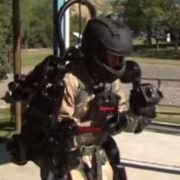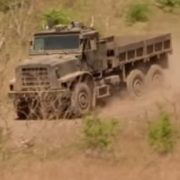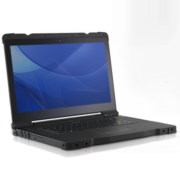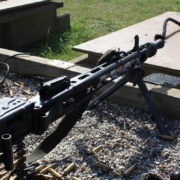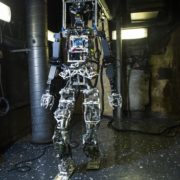Recently, we took a gander at “Recon,” a TV show on ArmedForcesUpdate. Their episode on “Future Soldier” is a step above most Defense videos. In a relatively brief time, they cover exoskeletons, invisibility cloaks, small arms, sensor systems, brain-machine interaction, power sources, helmet technology, and body armor. The role of end-user feedback as well as cost, requirements, and basic challenges are also mentioned. Intelligent research scientists are prominently featured talking intelligently. Best of all, the hard-driving rock music, which is the bane of so many Defense videos, is only minimally present.
Posts
Ever have to explain LIDAR to a layman? Internal mapping? Autonomy? In a brief period of time, this BBC video does an admirable job of explaining in jargon-free terms some of the issues surrounding autonomous vehicles. This short video shot an autonomous 10-ton, 6-wheeled truck running through its paces, as an BBC announcer described the significance of its actions.

Build-Your-Own-Module (BYOM)
Tablet Modules

SINGLE FINGERPRINT SCANNER
DUAL FINGERPRINT SCANNER
DUAL FINGERPRINT SCANNER
SMART CARD READER
MAGNETIC STRIPE READER
2D BARCODE READER
Compatible models: BioSense & BIOPTIX Tablets

Build-Your-Own-Module (BYOM)
Smartphone Modules

DUAL FAP45 FINGERPRINT MODULE
SINGLE FAP45 FINGERPRINT MODULE
Compatible models: BioFlex® Smartphones
 AMREL announced the launch of thinnest rugged laptop with a 15” display. Leveraging 30+ years of experience of supplying rugged computers to warfighters as well as Public Safety officers, AMREL has developed a fully rugged laptop that is just 1.25 inch thick.
AMREL announced the launch of thinnest rugged laptop with a 15” display. Leveraging 30+ years of experience of supplying rugged computers to warfighters as well as Public Safety officers, AMREL has developed a fully rugged laptop that is just 1.25 inch thick.
“Durable, rugged computers are traditionally regarded as heavy and cumbersome,” explained Kalvin Chen, AMREL’s VP of Operations. “However, slimmed-down computers are becoming increasingly popular. At AMREL, we believe soldiers, police officers, and other end-users deserve the best of both worlds so we introduced our ‘Tough & Thin’ series. This series is dedicated to reducing the size, weight, and power for their mission and application. The 15” ROCKY RV11 laptop is our latest addition.”
AMREL’s “Tough & Thin” series includes:
- ROCKY DB6 – Atom-powered handheld that is the smallest rugged computer in the world with full Windows OS
- ROCKY DF6 – ARM-based handheld which runs the Windows CE
- ROCKY RS11 13” laptop – Only 1” thick
- An Android handheld is expected to be released soon
“The ROCKY RV11 is an important member of this series,” states Mr. Chen, “because 15” is the size that most of our clients demand for laptop displays.”
Like all AMREL products, ROCKY RV11 is fully rugged. Independently certified for MIL-STDs 810/ 461, and IP65, it comes standard with a durable Solid State Hard Drive. Yet, it weighs only 8.16 pounds and is just 1.25 inches thick.
Despite its thinness, ROCKY RV11 doesn’t skimp on power. It has a powerful Intel® Core™ i7 Processor, well-suited for modern data-intensive applications.
Perfect for applications that require rigorous field work, heavy data input, and a large display, the ROCKY RV11can be used for:
- Onsite Data Collection & Management
- Front-Line Mapping & Situational Awareness
- Oil & Gas, Mining, and Construction
- Field Research & Surveying
- Combat Control Solutions
To learn more about the RV11 click here.
Since AMREL customizes most of the products we sell, we pay pretty close attention to what our customers want. While we do not claim to be prophets, we have noticed certain trends when we discuss computing solutions with our clients. Here is what we think will be “The Next Big Things” for rugged computers.
Big displays/ Small form factors
We get a lot of inquires about the RF10, the only rugged laptop that has a 17” display. Same thing about our DK10 tablet that has a 12” display. Maybe it’s the popularity of mapping applications or maybe everyone is aging and getting poor eyesight. Whatever the reason, people want BIG screens.
At the same time, they want smaller form factors. People are using tablets for tasks that once required laptops, and are using handhelds for applications that once needed tablets. Please call us if you know how to put a 17” display on a smartphone.
ARM race
One key to the popularity of smaller from factors are ARM processors. While more limited in their ability to support full computer functions, they use less energy than traditional processors (such as Intel).
To get around the limitation of ARM processors, computing solutions have adopted “fat server/thin client” model. Computing functions are off-loaded to the cloud. You no longer need a powerful desktop computer to download your email. When your email is cloud based, a simple low powered smartphone can easily check it.
My smartphone, my trash
A consequence of the preference for ARM- based small form factors is that hardware is cheaper and more disposable. If your desktop computer is destroyed, you have not only lost an expensive piece of equipment, but also a lot of valuable data as well. If your smartphone gets trashed, it’s less expensive to replace, and your data lives on in the cloud.
Considering disposability is one of its main attractions, a smartphone that is also rugged may sound like a contradiction in terms. Even if it is relatively cheap to replace, a broken smartphone is still a time waster and a general pain in the rear end. So, we are getting many requests for durable handheld computers. In addition to the DB6, DF6 and our other established small platforms, we plan to soon launch a new line of super-tough handhelds.

Build-Your-Own-Module (BYOM)
Tablet Modules

SINGLE FINGERPRINT SCANNER
DUAL FINGERPRINT SCANNER
DUAL FINGERPRINT SCANNER
SMART CARD READER
MAGNETIC STRIPE READER
2D BARCODE READER
Compatible models: BioSense & BIOPTIX Tablets

Build-Your-Own-Module (BYOM)
Smartphone Modules

DUAL FAP45 FINGERPRINT MODULE
SINGLE FAP45 FINGERPRINT MODULE
Compatible models: BioFlex® Smartphones
Android rules, but mobile Windows is not dead yet
Android OS is clearly on the rise. Interestingly, this has not slowed down inquires to AMREL for Windows CE-based platforms. Institutions with legacy applications haven’t jumped on the Android bandwagon yet. While continuing to support mobile Windows OS, we plan to dramatically expand our Android offerings in the near future.
Attack of the super-thin computers
As you probably noticed, thin is in. Leaf through any computer magazine, and you will see ads boasting of their slim platforms. While this is primarily a phenomenon of consumer electronics, even the rarefied world of rugged platforms has been affected by “computer anorexia.”
Never one to pass up a good trend, AMREL offers:
• RS11 – With a 13” display, it’s the thinnest rugged laptop in the world
• DB6 – The super lightweight handheld
• RV11 – It is the thinnest rugged laptop with a 15” display on the market
This year we plan to offer a rugged tablet so thin you can cut cheese with it. Well, maybe not that thin, but still…
COTS, COTS, and more COTS
Classify this trend as “more of the same.” One of the biggest consumers of rugged platforms is the US Department of Defense (DOD). They have been COTS obsessed for years, and there is no sign of this mania letting up. COTS products are supposedly cheaper, have better supply lines, and the DOD doesn’t have to worry about keeping their production capabilities alive in times of low demand.
Of course the DOD still hasn’t lost its taste for highly specific requirements. This has led to the phenomena of “Customized COTS,” i.e. off-the-shelf products that can be easily modified. For almost 30 years, AMREL has pioneered “Customized COTS” and continues to be a leader in this field.
Quick & inexpensive prototyping
Incorporating end-user feedback for rugged solutions has always been problematic. With the pace of technological change rapidly accelerating and the increasing uncertainty surrounding possible future wars, adaptability has become ever more critical. Rugged solutions must be designed to be easily and inexpensively modifiable. Since customization is one of AMREL’s core capabilities, we feel very confident in meeting this challenge.
What do you think?
The above list is not be meant to be exhaustive, but just an informal collection of our impressions. What is your vision of the future of rugged computers? Send your thoughts to editor@amrel.com.
Learn more about AMREL’s offerings at computers.amrel.com

Build-Your-Own-Module (BYOM)
Tablet Modules

SINGLE FINGERPRINT SCANNER
DUAL FINGERPRINT SCANNER
DUAL FINGERPRINT SCANNER
SMART CARD READER
MAGNETIC STRIPE READER
2D BARCODE READER
Compatible models: BioSense & BIOPTIX Tablets

Build-Your-Own-Module (BYOM)
Smartphone Modules

DUAL FAP45 FINGERPRINT MODULE
SINGLE FAP45 FINGERPRINT MODULE
Compatible models: BioFlex® Smartphones
Do you need a computer that is night vision compatible? Before you buy, you should know the answers to these 10 questions.
What is a night vision compatible computer?
Night vision compatible computers do NOT possess the capabilities of night vision goggles. They do NOT allow you to see in the dark. Instead they restrict their emission of light, in order to prevent interference with or detection by night vision goggles.
Who needs a night vision compatible computer?
Generally, there are two classes of people who need night vision compatible computers: aviation crews and military ground troops, especially Special Forces. Ground forces use computers with decreased light emissions to avoid detection by the enemy. Airplane crews need computers whose light emissions are restricted, so they don’t blind a nearby pilot who is using night vision goggles.
Are there differences between night vision compatible computers used by aviation crews and those used by Special Forces?
Yes. Filters used to suppress the transmission of light have different level of strength. AMREL’s off-the-shelf night vision solutions use filters that permit light transmission of 2.5%, which is a commonly requested level (alternative filter ranges are available by request). Special Forces requirements can go as low as 1%. Aviation standards (MIL-STD 3009) are not as strict and permit 20% transmission.
One reason there are differences between the two types of night vision compatible computers is that they are used differently. A pilot will use his night vision goggles to fly, but will switch to using his naked eye when viewing instrumentation within the cockpit. On the other hand, a soldier on the ground will use his night vision goggles to view nearby objects as well as ones in the distance.
Another difference is that aviators prefer their night vision to have an anti-glare surface. Ground troops on the other hand do not care.
Sometimes, the markets overlap; Special Forces in airplanes will use computers with night vision solutions to avoid blinding the pilot who is using goggles to fly.

Build-Your-Own-Module (BYOM)
Tablet Modules

SINGLE FINGERPRINT SCANNER
DUAL FINGERPRINT SCANNER
DUAL FINGERPRINT SCANNER
SMART CARD READER
MAGNETIC STRIPE READER
2D BARCODE READER
Compatible models: BioSense & BIOPTIX Tablets

Build-Your-Own-Module (BYOM)
Smartphone Modules

DUAL FAP45 FINGERPRINT MODULE
SINGLE FAP45 FINGERPRINT MODULE
Compatible models: BioFlex® Smartphones
What is “black background”?
Some Naval applications demand that that night vision compatible equipment emit zero radiation when they are turned off. The requirement for this specification is called “black background.” This leads to stricter requirements than is found in aviation applications.
Can night vision compatible computers have a workable touch screen?
Yes. The filter can diminished the effectiveness of the touch screen slightly, but most people do not notice this.
Why is the suppression of infrared range emissions important?
Night visions goggles use infrared (IR) range. Therefore, night vision filters must suppress light transmitting in that range, so that an enemy using night visions goggles cannot see their computer. Sometimes, you will see phrases about night vision compatible computers, such as “…. reduces your infrared signature.”
Consider the following graph used by Cevians, LLC (formerly a division of Wamco Inc.), an industry leading supplier of filters, to illustrate the suppressive properties of one of their products. Infrared starts at about 700 nm, so this graph shows zero transmission in that range.
What is “full color rendering” and do I need it?
Night vision filters can suppress the spectrum unevenly. Sometimes, the image on the display of a night vision compatible computer will look distorted, even monochromatic.
This is a problem for a variety of applications, especially mapping, which may use color to convey critical detail and information
Night vision filters can be constructed for “full color rendering.” Red looks red, yellow looks yellow and so on. For many applications, this is essential.
What the heck is U´ and V´?
Pronounced “U prime” and “V prime,” these coordinates describe color distortion caused by filters (even “full color” ones have some). An expert can look at u’ and v’ and know how whether or not the filters are appropriate for his application.
Why should I care if my filter is “polymeric”?
Filters made from polymeric materials are not flammable. Especially important for aviation applications.
Are night vision compatible computers “sunlight readable”?
Not with the filters on. Many night vision compatible computers have filters that are removable, so they can be used in the daytime. This leads to an important often unasked question, “Where the heck do I put my night vision filter when I am not using it?” This may seem to be a trivial detail, but when designing a night vision solution, it is an important consideration.
Click here to learn about AMREL’s night vision solutions.

Build-Your-Own-Module (BYOM)
Tablet Modules

SINGLE FINGERPRINT SCANNER
DUAL FINGERPRINT SCANNER
DUAL FINGERPRINT SCANNER
SMART CARD READER
MAGNETIC STRIPE READER
2D BARCODE READER
Compatible models: BioSense & BIOPTIX Tablets

Build-Your-Own-Module (BYOM)
Smartphone Modules

DUAL FAP45 FINGERPRINT MODULE
SINGLE FAP45 FINGERPRINT MODULE
Compatible models: BioFlex® Smartphones
We live in the golden age of manly cooking. Across our great land, manly men are frying whole turkeys, using power tools to inject cheese into hot dogs, and tenderizing steak by blowing meat out of cannons.
One person had the vision to take manly cooking to its logical conclusion. Writing in Reddit, Oelund described how to fry bacon with a 7.62 mm machine gun.
In the comments sections, he said he was partially inspired by stories of British soldiers boiling tea with their automatic weapons in WW I. Boiling water is a good way of making sure what you are drinking is healthy (securing potable water can be a problem in a war zone).
However, manly men don’t care about health! We want bacon! (Come to think of it, if you’re the kind of guy who uses automatic weapons to cook, health may not be your number 1 priority anyway.)
Below are the photos and instructions Oelund posted. With its discussion of whether America is falling behind in the bacon race and the most economical machine gun to use for cooking, the comments section is worth reading.

Build-Your-Own-Module (BYOM)
Tablet Modules

SINGLE FINGERPRINT SCANNER
DUAL FINGERPRINT SCANNER
DUAL FINGERPRINT SCANNER
SMART CARD READER
MAGNETIC STRIPE READER
2D BARCODE READER
Compatible models: BioSense & BIOPTIX Tablets

Build-Your-Own-Module (BYOM)
Smartphone Modules

DUAL FAP45 FINGERPRINT MODULE
SINGLE FAP45 FINGERPRINT MODULE
Compatible models: BioFlex® Smartphones
I’ve discovered a new way of cooking bacon. All you need is: bacon, tin foil, some string, and.. oh whats it called?… oh yeah, an old worn out 7.62mm machinegun that is about to be discarded, and about 200 rounds of ammunition.
You start by wrapping the barrel in tin foil. Then you wrap bacon around it, and tie it down with some string.
you then wrap some more tin foil around it, and once again tie it down with string.
It is now ready to be inserted into the cooking device. I ripped the tin foil a little bit getting the barrel inserted. that part of the bacon got severely burned by hot gasses.
After just a few short bursts you should be able to smell the wonderful aroma of bacon.
I gave this about 250 rounds. but I think around 150 might actually be enough. But then again I don’t mind when bacon is crispy. Ahh the smell of sizzling bacon mixed with the smell of gunpowder and weapon oil.
And the end result: Crispy delicious well done bacon.
Note: AMREL advocates responsible use of high-powered firearms and does not recommend using machine guns to cook bacon or anything else. Although, we’ll think you’re cool if you do so.

Build-Your-Own-Module (BYOM)
Tablet Modules

SINGLE FINGERPRINT SCANNER
DUAL FINGERPRINT SCANNER
DUAL FINGERPRINT SCANNER
SMART CARD READER
MAGNETIC STRIPE READER
2D BARCODE READER
Compatible models: BioSense & BIOPTIX Tablets

Build-Your-Own-Module (BYOM)
Smartphone Modules

DUAL FAP45 FINGERPRINT MODULE
SINGLE FAP45 FINGERPRINT MODULE
Compatible models: BioFlex® Smartphones
For five years, researchers at Virginia Tech have been working on the human-like, bipedal Shipboard Autonomous Firefighting Robot (SAFFiR). Recently, the SAFFiR was successfully tested on the Chatwal, the Navy’s firefighting ship.
SAFFiR used LIDAR (rotating lasers) to navigate through dense smoke across uneven floors. It located hot spots with its stereoscopic thermal imaging cameras, and dowsed a small fire with a hose.
SAFFiR stands at five feet, ten inches and weighs 143-pounds. Its electrical motors are protected from water by raingear.
It may have autonomous in its name, but currently it is controlled by human operators through a console. Eventually, natural language and gestures will be additional control options.
Shipboard fires are a nasty business. Not only do flammable systems and ordinances pose a threat, but also human firefighters may not have the latest training. Indeed, their responses may actually make the situation worse.
SAFFiR is bipedal so it can work in the cramped shipboard environments designed for humans. Eventually humans and unmanned systems will integrate into hybrid firefighting teams.
SAFFiR is sponsored by the Office of Naval Research (ONR). ONR plans to expand SAFFiR’s duties to include checking for leaks, scanning for corrosion, and taking measurements.
AMREL now offers a full line of turn-key night vision solutions, fully compliant with MIL-STD 3009 and CECOM (CSLP) standards.
“AMREL’s rugged laptops, tablets, and handhelds are the perfect platforms for night vision solutions,” states Kalvin Chen, AMREL’s VP of Operations. “The durability and reliability of our computers makes them practical for both ground and aviation purposes.”
The widespread use of night vision goggles has necessitated the adoption of light restricting filters for mobile computers. Aviation crews must be careful that the light of their laptops and tablets do not blind pilots who use night vision goggles to fly in dark, dangerous areas. Military forces on the ground are keen that enemies cannot detect their presence by using night vision goggles to spot light emitting from their tactical computers.
“Special Forces have used AMREL’s rugged computers for years,” explains Mr. Chen. “We are especially pleased that we can offer them this feature, which enhances their safety by limiting their detectability. Of course, our night vision computing solutions also meet the less stringent aviation standards.”

Build-Your-Own-Module (BYOM)
Tablet Modules

SINGLE FINGERPRINT SCANNER
DUAL FINGERPRINT SCANNER
DUAL FINGERPRINT SCANNER
SMART CARD READER
MAGNETIC STRIPE READER
2D BARCODE READER
Compatible models: BioSense & BIOPTIX Tablets

Build-Your-Own-Module (BYOM)
Smartphone Modules

DUAL FAP45 FINGERPRINT MODULE
SINGLE FAP45 FINGERPRINT MODULE
Compatible models: BioFlex® Smartphones
AMREL’s Night Vision Computing Solutions virtually eliminate all infrared emissions completely, which is important, since night vision goggles usually work in that part of the spectrum. Overall light transmissions are restricted to just 2.5%. Other levels of light suppression are available on request.
AMREL Night Vision Solutions use the industry-leading SafeNight™* filters. These polymeric filters are nonflammable and offer full color rendering, which is important for mapping applications.
AMREL Night Vision Computing Solutions are available for:
- ROCKY RS11, the lightest, thinnest rugged laptop in the world (13.3” display)
- ROCKY DK10 fully rugged tablet (12.1” display)
- ROCKY DB6 handheld, the smallest, fully rugged handheld with full Windows OS (5” display)
- Other computing platforms available upon request.
For more information, visit: http://computers.amrel.com/?p=7491
*“SafeNight” trademark is property of CEVIANS, LLC – Formerly a division of Wamco Inc.
Are tanks obsolete? Not if combat involves tennis playing, as the video below demonstrates. No word if the tank can jump over the net if it wins.
After being totally blown away by the M1 Abrams’ speed and agility, I learned this video is FAKED. Still, this brings up a very real issue. If tanks in reality can’t play tennis, what are they good for?
Army Chief of Staff Odierno testified that in 2012 before Congress that “…we don’t need the tanks. Our tank fleet is two and a half years old on average now. We’re in good shape and these are additional tanks that we don’t need” (Military.com). Congress went ahead and approved the purchase of additional, unwanted tanks. The fact that tanks are produced in Ohio, a critical state in presidential elections is just a coincidence.
Even before Odierno testified, some folks were touting the tank’s demise. Some pointed to the widespread destruction of Israeli armor in the 1973 war by handheld anti-tank weapons as a sign of the tank’s obsolescence. On the other hand, Michael Peck in War is Boring notes that the Israeli losses happened when they violated basic tactical rules, such as failing to support tanks with infantry.
To get an idea about the debate I suggest you read a summary of different points of views in The Atlantic The Wire. It’s a bit dated, but the arguments are still relevant.

Build-Your-Own-Module (BYOM)
Tablet Modules

SINGLE FINGERPRINT SCANNER
DUAL FINGERPRINT SCANNER
DUAL FINGERPRINT SCANNER
SMART CARD READER
MAGNETIC STRIPE READER
2D BARCODE READER
Compatible models: BioSense & BIOPTIX Tablets

Build-Your-Own-Module (BYOM)
Smartphone Modules

DUAL FAP45 FINGERPRINT MODULE
SINGLE FAP45 FINGERPRINT MODULE
Compatible models: BioFlex® Smartphones
Recently, Chief of Staff Gen. Raymond T. Odierno gave a presentation to the Association of United States Army on “Force 2025 and Beyond.” If you want to know what the Army’s head honcho is planning for its future, check out this nifty PDF.
One thing that will definitely not change is the military’s fondness for acronyms. Reading Odierno’s presentation requires a high tolerance for initials as well as an instinctual knowledge about matters such as the difference between USAPRAC and USPACOM. After wandering through his dense forest of acronyms, I came away with the following impressions:
The Army doesn’t have a clue about the future. While it is true that he identifies possible threats, you don’t have to read between the lines too much to know that Odierno has no idea what kind of war the Army should prepare for. This is not a big surprise, and is something that this blog has discussed before (see here).
Odierno’s solution for this quandary? Among other things, the Army needs “adaptability.” I suggest you play a drinking game with a buddy. Download the PDF of Odierno’s presentation, and have your friend read it out loud. Every time he says “adapt” or “adaptability,” take a shot. You may want to start off with something light, because you’ll take 6 shots on the first page alone.
Doubling down on technology. Seeing a high-level bureaucrat reject common institutional wisdom is a bit like watching a magnificent sunrise. It has happened before and it will happen again. However, you should still pause and admire its beauty.
Odierno clearly feels like he is operating in a financial squeeze (in real terms, the Defense budget continues to rise). However, he is not following the usual institutional practice of cutting Research & Development in times of austerity. Odierno could have simply followed recent trends and simply off-loaded R&D responsibilities onto vendors, i.e. “I don’t know what we want, but I want you to build it.”
While the Army will use commercial suppliers, Odierno makes it clear that he is not abandoning R&D. In fact, technology and innovation is a big priority and he discusses it a great deal.
While I applaud Odierno’s not sacrificing R&D on the budget chopping block, I do wonder about the US military’s continued reliance on technology to give it an “edge” (or in Odierno-ese, “overmatch capabilities”), especially in counter-insurgency scenarios. Does it make sense to use million dollar missiles to destroy ancient pick-up trucks?
Most US military personnel in the Pacific region belong to the Army. Odierno makes a point of making this point. You know all those folks who say that the Pacific Tilt means cutting the Army’s budget, so that money can be diverted to the Air Force and Navy? This is Odierno’s way of thumbing his nose at them.
80% of “rotorcraft” will be replaced. Good time to be a helicopter manufacturer.
High Energy Laser Mobile Demonstrator (HEL MD) will reduce the need for stockpiles. Yeah! We’re finally going to get ray guns! Or at least “ray cannons.”
“Alternative sources of water.” What has the Army learned after fighting for 13 years in an arid environment? The importance of water. I wouldn’t be surprised that out of all the technologies the military is currently developing that water purifications and generation end-up being the most world changing.
Healthcare & medicine. More than a few areas of technological development that Odierno describes involved healthcare of some kind. Considering its skyrocketing cost, not a big surprise.
The future of unmanned systems is so last year. Odierno mentions Autonomous Aerial Resupply as a “potential capability.” This is the only time he mentions unmanned systems.
I have been optimistic about the role of unmanned systems in US forces (see here). However, their relative absence from a technology-heavy discussion by the Army’s Chief of Staff does raise a red flag. Vendors of unmanned systems have visions of military robots doing everything from flipping burgers to fighting fires. If they want the Army to share that vision, they have some work to do.
“Sustaining investments in the technical workforce is paramount…However, sequestration could undermine these efforts.” Some congressmen have been vigilant in protecting soldiers form budget cuts. Not so much the military’s civilian workforce, which has been hammered by reduced funds. Odierno wants folks to understand that the guys who carry guns and wear camouflage are not the only ones who need protecting. The guys who carry calculators and wear white shirts are also important.
Odierno covers a lot of ground in his brief discussion. The above list is far from complete and only represents my overall impression. His presentation is worth reading in its entirety.
What do you think? What struck you about Odierno’s presentation?
Send your thoughts to: editor@amrel.com

Build-Your-Own-Module (BYOM)
Tablet Modules

SINGLE FINGERPRINT SCANNER
DUAL FINGERPRINT SCANNER
DUAL FINGERPRINT SCANNER
SMART CARD READER
MAGNETIC STRIPE READER
2D BARCODE READER
Compatible models: BioSense & BIOPTIX Tablets

Build-Your-Own-Module (BYOM)
Smartphone Modules

DUAL FAP45 FINGERPRINT MODULE
SINGLE FAP45 FINGERPRINT MODULE
Compatible models: BioFlex® Smartphones
American Reliance, Inc.
789 N Fair Oaks Ave,
Pasadena, CA 91103
Office Hours
Monday-Friday:
8:00 am – 5:00 pm PST
Saturday: Closed
Sunday: Closed
Main: +1 (626) 482-1862
Fax: +1 (626) 226-5716
Email: AskUs@amrel.com
Blog Posts
Mobile Biometric Solutions
Mobile Biometric Smartphones & Tablets
BioFlex S® Commercial Smartphones
BioSense AT80B | 8″ Android Biometric Tablet
BioSense PA5 | 10.1″ (Gen 2) Android Biometric Tablet
BioSense PA5 | 10.1″ Android Biometric Tablet
BIOPTIX PM3B | 7″ Windows Biometric Tablet
BIOPTIX PM5B | 10.1″ Windows Biometric Atom Tablet

